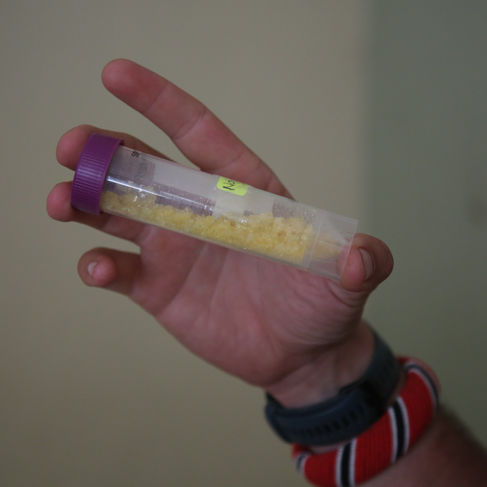Antivenom: The implications for Kenya’s residents, reptiles and rangers
- For Rangers

- Aug 4, 2023
- 6 min read
Written by Jimmy Rutherford.
Rear-fanged, front-fixed, and front-hinged are examples of the varied assortment of fang types displayed in Africa’s many venomous snake species. Whilst their deliveries of potent venoms to tackle prey from rodents to reptiles have been perfected over millions of years, they have also been a danger to humans. As a result, snake-related injuries and deaths remain widespread, though the severity of a snakebite depends on many factors. Some will leave little more than a swelling, whilst others can kill within hours; some will deliver a dry bite (leaving no venom behind), whilst others, including hatchlings, could deliver a fatal dose (no questions asked).
And the mamba is one of these. Timid but widespread across Africa, mambas have small front-fixed fangs measuring around 4mm in length, which deliver a highly potent neurotoxic (affecting the nervous system) and cardiotoxic (affecting the heart) venom with a LD50 of 0.30mg/kg. LD50 is a value that represents the quantity of venom that would be lethal for 50% of a test population. By comparison, the Ashe’s spitting cobra (Naja ashei), a much larger snake that produces 6.2mg compared to the mamba’s 0.170mg, has a LD50 of 2.29/kg.
The World Health Organisation (WHO) has set the target to reduce snakebite-related deaths by 50% by 2030. The trouble is, antivenom availability is lacking across the African continent, with Kenya having just one WHO-approved antivenom available. The Taylor Ashe Antivenom Foundation (TAAF) is currently going through the licensing processes set forth by the Kenya Wildlife Service (KWS), and then, as and when approval is acquired, it can begin to provide ethically acquired venom to companies developing much-needed antivenoms.
One of the first steps in this endeavour was the acquisition of suitable enclosures for TAAF’s boomslangs and mambas. ForRangers was able to help fund this, with a grant of US $10,000 to purchase 48 such enclosures. Custom-designed by the Farm’s curator, Kyle Ray, they are easier to clean, safer for the team to use and smooth, preventing injuries to the snakes from nose rubbing. After thanking ForRangers’ donors, Bonface Momanyi, Watamu Snake Farm Manager, went on to say: “The snakes look happy inside them and there is no rubbing of [the] mouth. The temperatures inside these cages are conducive to the snakes and, last but not least, the risk of a snake escaping has been mitigated.”
Most of the enclosures are now occupied but the team still has its work cut out. Not only does TAAF need to acquire more snakes to meet the demand for venom, but it must also continue its work to educate people across Kenya about the efficacy of modern antivenom. Today, it is still common for people to seek out traditional healers to cure their snakebite-related injuries. TAAF encourages people to use scientifically and medically approved treatments, including antivenoms.
On a recent trip to Kenya, I was fortunate to join the TAAF team, when I went out with the guys on a ‘Snake Safari’. It was tipping it down and the local Giant African land snails were out in abundance having a ‘snail of a time’. Three of us had taken shelter under an abandoned hut 10 or so metres away and were convinced that there was no chance of Emmanuel finding anything in this weather. But, to our surprise, and emphasising just how skilled these snake handlers are, there, hidden under the roof away from the downpour, he found a speckled sand snake. Long but slight with striking black stripes running sharply down its spine above individual speckles centring each one of its scales, it was, as Steve Irwin used to say, “a little beauty!” After checking it over, the snake was released back where we found it, as it is a harmless species and, given its speed, it is usually able to avoid people.
A mamba however is a different story.
Later that morning, we were visiting an impressive cave, a site cherished as a place of healing by many local people. Offerings and the remains of various rituals lay strewn about the cave floor and rockfaces, signs of just how rooted traditional practices are in the culture here. As we sat below the high ceiling to hide from the torrential downpour, Kyle’s phone rang, with Emmanuel on the line.
“Nyoka, nyoka!” Emmanuel had followed a series of bird alarm calls to a densely branched tree on nearby farmland. Following his whistles amongst the pounding rain and thick vegetation, we found him in a clearing surrounded by a small group of cows. He was eyeing the treetop where a lime-green mamba slid through the highest branches. With little hesitation, Emmanuel began to climb up through the tree before grasping the mamba in the snake grips and lowering it down to Kyle below. The snake was examined and gently placed in a cotton bag with two knots tied tightly around the top (two knots for highly venomous and one for harmless). Sadly, being highly venomous and found amidst human settlements, ‘Jimmy’ as he is now known, was taken to TAAF, as it would have been only a matter of time before he was killed or bit someone (as we worked, young children wandered past, mere metres away from the tree).
Back at TAAF’s base, I was shown a demonstration of the milking process. An Ashe’s spitting cobra, a species discovered by the Foundation’s very own founder, James Ashe, was carefully lifted out of a box. Three people always participate in the milking session: one removes the snake from the container and places it on a non-slip mat, the second guides it into a tube to safely restrain it and the third supports the body and takes it over to the milking table. The lead handler places the head over a funnel covered by a thin veil of parafilm. As the snake bites, it releases venom into the vial below. It was fascinating to witness, but also somewhat unnerving, knowing that is what would enter your bloodstream if you were bitten. Given its superior speed and agility, when it comes to milking a mamba, the team must be on an even higher level of alert!
After each bite, the container is weighed and then either dried immediately or, given its perishability, frozen if drying cannot occur soon after. Drying takes place in a vacuum dryer for three days, resulting in a substance that resembles sugar crystals. It is this dried venom that TAAF intends to sell for research and antivenom manufacture.
Manufacturing involves rehydrating the dried venom and injecting it in very small doses into horses. It takes about three months for the antibodies in the horse to accumulate to a sufficient-enough potency, at which point they can be extracted (this is not harmful to the horse). The plasma is separated out of the sample and used to manufacture antivenom whilst the red blood cells are returned to the host animal. Most antivenom manufacturers produce a polyvalent antivenom, which will cover all the snakes the horse has been immunised with.

An infographic detailing the process of developing antivenoms. Image credit: TAAF
Large-scale manufacture of antivenoms from the Farm’s snakes is still a way off. But, thanks to the team’s hard work, a huge change in attitude from many Kenyans towards snakes has been seen already. The number of calls the team receives to help catch and remove snakes is a testament to this. TAAF also sees a lot more people who don’t want snakes to be killed, and, after learning the snake in their garden is harmless, they are often happy to leave it there.
The team has also been passing on its skillset to rangers across Kenya, travelling to the likes of conservation areas such as Borana and Lewa Wildlife Conservancies and the Masai Mara to train the teams on how to deal with snakes safely. Mamai Ole Ntirra, Corporal in charge of the Oloisuti station had this to say about the training courses provided:
“The training [course] was great. Now I know how to identify different types of snakes and also tell those with toxins and those without.”
However, despite these efforts, eradicating bites from occurring entirely is unachievable. It is perfectly possible to be caught completely off guard, as was the case recently in Zambia when a ranger was bitten by a black mamba whilst working out in Kafue National Park. After two nights of being in a critical condition, he recovered and returned to work with little to no long-lasting effects. He was very lucky.
The development of widespread, effective, and affordable antivenoms is essential to ensure coexistence between people and serpents. TAAF has countless plans, and the new and improved enclosures provided, thanks to ForRangers’ donors, is an early step in the development of something very exciting, benefiting wildlife, rangers and other people across Kenya and beyond.






















Comments